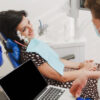The Telltale Signs of TMJ
Do you have chronic headaches, jaw discomfort, ear problems or sleep disorders? These are among the common symptoms of TMJ, a widespread but poorly recognized condition. Few physicians, dentists or other medical specialists have proper training in the diagnosis or treatment of TMJ, making this the most frequently misdiagnosed medical/dental condition. As holistic dentists, we are trained in recognizing the symptoms of TMJ, identifying the condition, and providing effective TMJ therapy.
TMJ Diagnostic Procedures
Conducting a thorough medical history and physical examination is the first step indiagnosing TMJ. We ask about all past medical and dental problems and treatments, medications used, and other relevant information, including any history of trauma, specific symptoms, and the location and intensity of pain.
Our cranial examination evaluates the planes of the skull including the dental plane of occlusion, while our dental examination evaluates the shape of the dental arches, swallowing patterns, wear or fractures on the teeth and other oral health clues to the state of the rest of the body. Neurologic examinations can reveal nerve or brain damage that may cause symptoms of TMJ. We also conduct a postural examination to identify any musculoskeletal problems that may contribute to or result from TMJ, such as scoliosis and lower back pain. The temperomandibular joint itself is examined to ascertain the ranges of motion, gait, speed and smoothness of jaw movements, and the joints palpitated to check for internal inflammation and other anomalies. We also use advanced diagnostic equipment and procedures to identify TMJ related problems. A Joint Vibrational Analysis records vibrations made by joint tissue during movement, and the electronic signatures are compared to those of healthy joints. Tomographs, x-ray slices of structures in the body, can reveal specific structures in the TM joints in great detail. Additional testing may include electromyography, which measures muscular activity, and computerized jaw tracking. These procedures enable us to make definitive diagnosis of TMJ disorders. Psychometric tests that compare patients’ responses to questions about their condition are very helpful in evaluating the severity and chronicity of TMJ problems.
Do you think you might have a TMJ-related disorder? Call or email us today to schedule a consultation, and let our dentists give you definitive answers and offer effective solutions.
Physical Examination:
This consists of several parts and may take up to two hours to complete. A complete exam should include the following (see text below the images provided by Dr. James E. Carlson and the Acculiner Corp):

This consists of several parts and may take up to two hours to complete. A complete exam should include the following:
- Postural exam to discover any musculoskeletal problems that either contribute to or are the result of TMJ problems. This includes scoliosis, lower back pain, and short leg syndrome among others. The human body functions best when aligned at right angles to the center of gravity.
- A cranial examination will evaluate the planes of the skull including the dental plane of occlusion.
- Dental Examination to evaluate the shape of the dental arches, swallowing patterns, wear or fractures of teeth, missing teeth and existing dental restorations and numerous other clues to what is happening in the patients body. The dentist will usually make models of the mouth so that the teeth and the dental arches may be more closely examined.
- Neurologic examination to test for nerve or brain damage that may cause symptoms of TMJ. Certain brain tumors will mimic TMJ symptoms.
- TMJ Examination to look at the ranges of motion, gait, speed and smoothness of jaw movements. The TMJoints will be palpated to check for internal joint inflammation, pain and the presence of joint sounds.

- Joint Vibrational Analysis records the vibrations made by joint tissues during movement. JVA technology, based on that used in US Navy submarines, records vibrations, not sounds. All sounds are vibrations, but not all vibrations are sounds. The JVA is much more accurate than palpation, a stethoscope or even the patient self-reports, when it comes to recording vibration in the joints. The patterns and the electronic signature of your joints are compared to known standards for healthy joints. This technology also provides important objective (factual) documentation so vitally important in personal injury lawsuits and for filing insurance claims.
- Radiographic (x-ray) Examination of the joints allows the doctor to see many important structures and conditions hidden from view. Common x-rays are a panoramic x-ray that is useful only for screening for fractures, tumors and severe breakdown of the joints. Tomographs provide the best view of the TMJoints. Tomographs are x-ray slices of structures in the body. This technique allows the doctor to look at specific structures in great detail. The TMJoint tomographs accurately depict the position of the condyle in the fossa, and show degenerative and traumatic changes in the bones of the joints.
- Other special tests include electromyography, which is a cousin of the electrocardiogram. As the electrocardiogram measures the muscular activity of dysfunctions of the heart muscle, electromyography measures the activity and dysfunction of head and neck muscles. This information is important in treatment planning and for documentation purposes. Computerized jaw tracking is another important diagnostic and treatment tool. Using a small, powerful magnet stuck to the gums below the lower front teeth, movements of the jaw can be measured with unprecedented accuracy. The jaw tracker can be combined with the JVA to provide the most comprehensive diagnostic and treatment information available today.

- Psychometric tests are standardized questionnaires that compare patient’s response to questions about their condition. This information is very helpful to the doctor in the evaluation of the severity and chronicity of TMJ problems. The most common and accurate test is the TMJ Scale.










